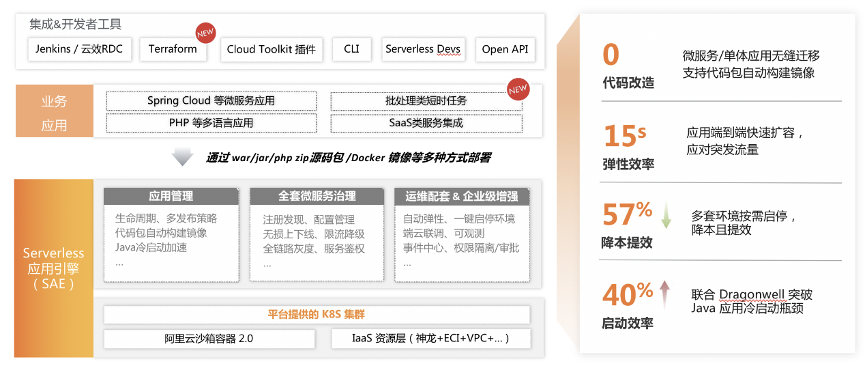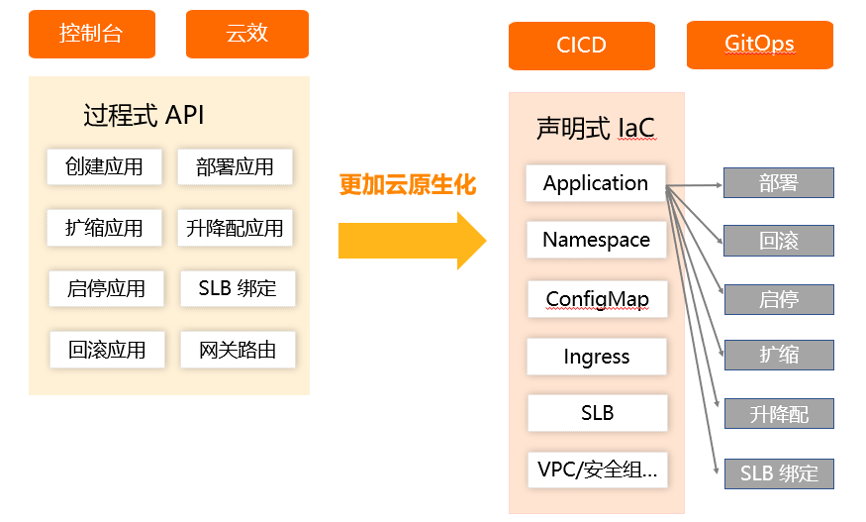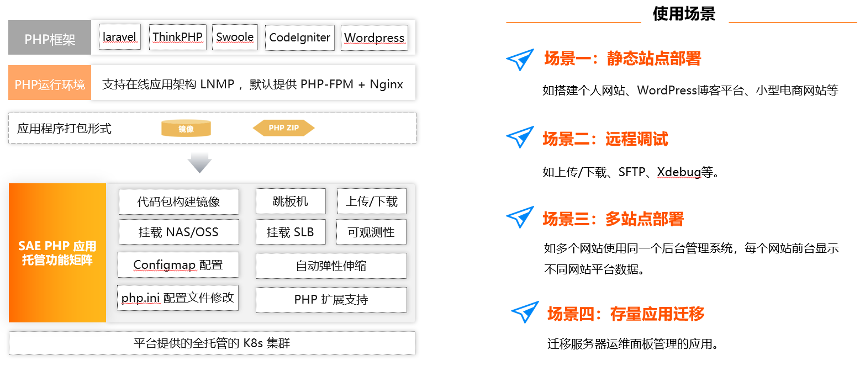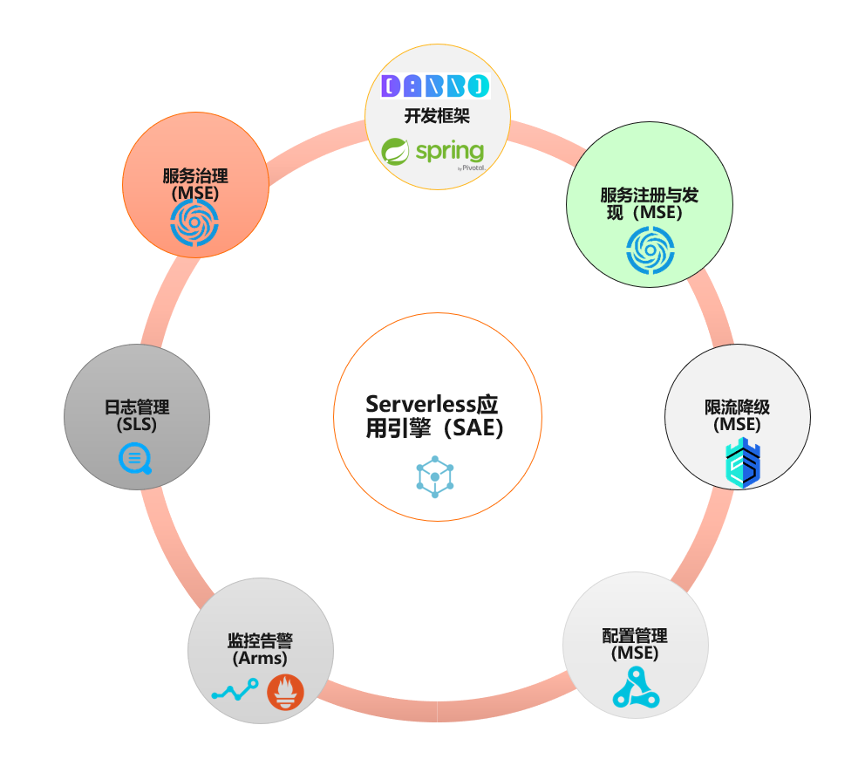Author: Campfire
Microservice capabilities have been greatly improved, new scenarios such as Job and PHP have been added, and new boundaries of serverless have been extended
Click here to get the live PPT of the Alibaba Cloud SAE conference!
With the popularization of the Internet, the digitalization of enterprises is developing faster and faster, and the technical structure has also changed several times. Especially in the online business part, there has been an advanced change from the initial single application to the distributed application to the cloud-native application. However, while bringing convenience, it also brings a certain degree of complexity to enterprises: the threshold for new technologies is high, and containers and microservices are two typical roadblocks. Even after microservice and containerization, enterprises still need to pay attention to server configuration, operation and maintenance, capacity evaluation, and face the challenges of high performance and stability, and cannot enjoy the maximum value brought by the cloud. The serverless application engine SAE, with its natural technical advantages, has helped thousands of enterprises realize the transformation of container and microservice technology. Recently, SAE not only further provides a full set of microservice capabilities, but also provides a new, more efficient, more economical and smooth migration solution for traditional Job and PHP users.
Recap of the live broadcast:
https://developer.aliyun.com/topic/sae
SAE combat training camp:
https://developer.aliyun.com/trainingcamp/7186cb983add45b093e46ab75bc7bf4a
The Serverless Application Engine SAE is a fully managed, O&M-free, and highly elastic general-purpose PaaS platform. It supports full hosting of open source microservices/open source timing task frameworks/web applications, and provides open source enhancements & enterprise-level features. It can be said that SAE covers the complete scenario of cloud application and is the best choice for application cloud application.
Three major new features, extending the new boundary of serverless
Serverless Job: New Transformation of Traditional Tasks
SAE Job is a new stop-and-go load type for SAE, focusing on task scenarios. According to business data processing requirements, a large number of computing tasks can be quickly created in a short period of time, and computing resources can be quickly released after the tasks are completed. It has the features of stand-alone, broadcast, parallel computing, fragmented operation, timing, automatic retry on failure, monitoring and alarming features, and provides a user experience that is fully managed and free of operation and maintenance.
Different from the traditional task framework, SAE Job is more convenient to use (no code intrusion), more economical (resources are released immediately after the task is run), more stable (independent from online business, and can automatically retry if the task fails), more transparent ( Visual monitoring and alarm), more worry-free (no need to pay attention to the underlying resources). More importantly, SAE Job can deeply integrate the microservice ecosystem and is compatible with open source K8s.
The main scenarios of SAE Job include scheduled tasks, data batch processing, asynchronous execution, offline computing, etc. At the same time, it supports zero-transformation and migration of traditional framework XXL Job, micro-service ecological integration, and improves the CI/CD process with the help of image building capabilities.
Compared with the traditional distributed task framework, SAE Job provides three core values:
- Complete and fully managed: SAE Job adopts a one-stop fully managed management interface. Its task life cycle, observability and other functions are out of the box. Users can use SAE with low mental burden and zero learning cost.
- Simple operation and maintenance: SAE Job shields the underlying resources, and users only need to focus on the core business logic development of the task, without worrying about cluster availability, capacity, performance and other issues.
- High resource utilization: In the SAE Job product model, it is used on demand and pays according to the amount. Only when the task executes the business logic, it will be charged when it is pulled up, and there is no charge for the rest of the time, which greatly saves the cost of resources.
SAE embraces the Terraform ecosystem and is more developer-friendly
As the preferred cloud tool for domestic and foreign large customers, Terraform's value lies in infrastructure as code, which can automatically configure infrastructure and help enterprises to develop, deploy and expand cloud applications with higher speed, lower risk, and lower cost. Greatly improve the efficiency of automated operation and maintenance. After SAE is connected to Terraform, developers do not need to understand every API, and provide declarative IaC, which makes operating SAE resources more secure, and connecting to CICD / GitOps is also simpler. More importantly, it provides resource orchestration capabilities, enabling one-click deployment of SAE and dependent cloud resources, greatly improving the efficiency of site construction from 0 to 1. Several Internet clients are already using it in production environments.
PHP one-stop application full hosting
When it comes to PHP operation and maintenance, everyone is familiar with various commercial versions of the server operation and maintenance panel. However, these panels only support stand-alone operation and maintenance, lack application-side monitoring and second-level automatic elasticity, do not support incremental update of static files, and are not friendly to larger PHP applications.
In response to the above pain points, SAE provides a fully managed service for PHP applications that is free of operation and maintenance, highly elastic, and seamlessly integrated with APM monitoring. In terms of framework, it supports popular frameworks such as laravel, ThinkPHP, Swoole, wordpress, etc. In terms of the operating environment, it supports the online application architecture LNMP, and provides PHP-FPM + Nginx by default. Support Docker image and PHP zip package deployment, greatly reducing the user threshold. The function matrix of PHP application hosting is quite rich, including uploading and downloading of development and debugging classes, built-in Xdebug, etc., as well as elastic scaling of runtime classes, APM capabilities, and independent management of static files and directories through NAS and OSS. Based on these capabilities, several typical usage scenarios of PHP are well supported: such as static site deployment, remote debugging, multi-site deployment, application migration of existing ECS/server operation and maintenance panels, etc.
SAE+MSE=Serverless Microservices Best Practices
Serverless microservices = CI/CD pipeline + microservice framework (including registry and microservice governance framework) + Kubernetes/container + cloud operation and maintenance (including call chain, log, alarm, performance monitoring, etc.) + elastic scaling service + traffic governance Serve.
The serverless application engine SAE deeply integrates the microservice engine MSE, and commercializes the best practices of microservices that Alibaba has been working on for more than ten years and has passed the test of Double 11. It can be used out of the box. Based on the open source Spring Cloud/Dubbo, it provides more powerful microservice governance capabilities.
White-screen PaaS: lowers the user's threshold for use, and its interaction meets the expectations of PaaS in most developers' minds. In addition, it also has rich integration capabilities such as CLI, plug-ins, and OpenAPI. This PaaS is actually a base that supports life cycle management, grayscale, and containerized transformation of microservice applications. If there is no such base, users may face a large number of commands or APIs for black-screen operations, and it is extremely complicated to get started. As an enterprise-level product, SAE also provides many enterprise-level features, such as namespace isolation, fine-grained permission control, and more.
Front-end and back-end full-link grayscale: This is the most common type of requirement in the production process of enterprises. It refers to grayscale to the new version instance by specifying cookies, headers and even the company's internal IP. SA E has opened up the HTTP request, the gateway , consumer, and provider, perform relevant routing on the Agent according to the rules, so that users only need to go through some white-screen configurations to achieve full-link grayscale.
Device- cloud joint debugging: Combined with the device-cloud joint debugging implemented by the Cloud Tookit plug-in, the number of applications in the micro-service architecture will be much larger than that of a single unit, so local development and debugging will be a problem. With the help of the IDEA provided by Cloud Tookit and mainstream IDEs such as Eclipse As a plug-in, developers can only need to start a consumer or provider locally to conduct joint debugging with the test environment on the cloud, which greatly reduces the threshold for microservices in the development stage;
Observability : Under the microservice architecture, there are a large number of applications, and it is difficult to locate problems. Observability is essential. SAE combines Alibaba Cloud's ARMS, cloud monitoring, SLS, Prometheus and other products, and is used in Metrices, Tracing, Logging, etc. All aspects provide relatively complete solutions to effectively solve the pain points of developers in observable aspects, including basic monitoring, call chain, real-time logs, events, etc.
For more information on SAE and microservices on the cloud, please scan the code to join the official user group:
Click here to go to the official website of Serverless Application Engine SAE to learn more!






**粗体** _斜体_ [链接](http://example.com) `代码` - 列表 > 引用。你还可以使用@来通知其他用户。